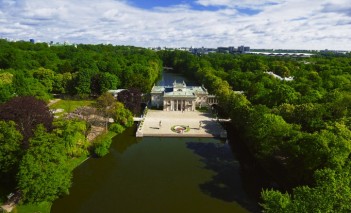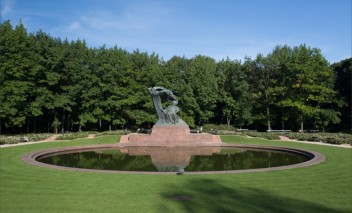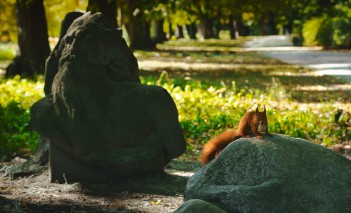The Dutch Garden is being created in the Royal Łazienki

Hundreds of tulips, narcissus, daffodils, then roses, hydrangeas and perennial plants will bloom in spring in the Orangery Garden of the Royal Łazienki. The plants will form the so-called Dutch Garden which has been designed by Dutchman Niek Roozen. - We want to enrich the surroundings of the Old Orangery by adding flowers, perennial plants and shrubs. We believe that, in spring, this place will reveal all its beauty which will last until late autumn - Barbara Werner, Chief Gardener in the Royal Łazienki, says.
The planting of the first species has already begun in the Dutch Garden. The work was overseen by designer Niek Roozen in person, who explained how his design should be implemented. A few bulbs were symbolically planted by Tadeusz Zielniewicz, Director of the Royal Łazienki and Barbara Werner, Chief Gardener in the Royal Łazienki.


- We are preparing the space in front of the Orangery for new plantings. We will keep numerous plants which are here already because they match ideally our plan - Niek Roozen said to the Virtual Museum.
The Dutchmen explained that he has been working on the design for the last few months together with Barbara Werner, the Chief Gardener in the Museum. Moreover, he added that he was pleased that he could implement the design in such a beautiful setting as the Royal Łazienki. - Planting will continue here in spring too. This space will always be full of flowers - Niek Roozen declared.
- For most people a Dutch garden associates only with tulips blooming in April and May. The design has been conceived in a way so that the garden in the Royal Łazienki can bloom permanently - Agnieszka Murawska from the Office of the Agricultural Counsellor in the Embassy of the Kingdom of the Netherlands added.



The Dutch Garden - as Barbara Werner, Chief Gardener in the Royal Łazienki, explained in a talk with the Virtual Museum - will decorate the Orangery Garden with flowers. - We are not changing anything in the historical layout of the space. No one would dare to interfere with its character; our purpose was only to enhance the beauty of it because flowers and shrubs are the major ornament of the garden, while the trees growing in Łazienki and surrounding this area are the force behind its preservation - stressed Barbara Werner.
The Orangery Garden will keep its systematic layout with the fountain situated in the middle - thus a layout which can be seen on the maps from the 18th and 19th century and which was recreated on the basis of historical accounts during the revitalisation of the Old Orangery and its closest surroundings.
- The Garden will be Dutch only in terms of the flower design. There won’t be any elements of Dutch architecture - explained Barbara Werner.


On spaces covered with grass and crossed by pathways, there will be four L-shape flower beds, while the bed flowers already existing along the wall of the Old Orangery will be enriched by new plants both annual and perennial. - The Orangery Garden can and should feature a rich diversity of plants - Barbara Werner stressed.
Some of the plants, including bulbous plants, will come from the Netherlands, and others - e.g. perennial plants - from Polish nurseries. In spring, the flower beds will see blooming tulips, narcissus, shrubs of magnolia, rhododendrons and azalea, and then, among other things, roses, hydrangeas and all the wealth of small plants filling in the beds. - It is an example of the great Polish-Dutch cooperation since the flowers come both from the Netherlands and Poland - the Dutch landscape architect, Niek Roozen, stated.
The plants which have existed in the Orangery Garden so far, e.g. magnolias or rhododendrons, will be preserved and only enriched with new flowers. - We expect that the new Orangery Garden will show its beauty in spring - Barbara Werner emphasised.
- Traditionally, the Orangery Garden is not only formed by citrus trees in wooden pots, which were displayed there already in the times of King Stanisław August, but also by flowers, perennials and shrubs - thus an abundance of everything that can be found inside and outside the Orangery where exotic plants are kept - Barbara Werner said.

The idea to enhance the Orangery Garden came from Willem-Alexander, King of the Netherlands during his visit to the Royal Łazienki. The design by the Dutch landscape architect Niek Roozen could be realised thanks to the generosity of Dutch and Polish companies; they liked the idea of adding flowers to the garden near the Old Orangery so much that they donated their own plants for this purpose.
- The Dutch garden is intended to show the tradition of Dutch love for flowers, nature, and broadly understood beauty that is also found in the Royal Łazienki which has had links with Dutch art since the beginning. At the end of the 17th century Dutchman Tylman van Gameren marked his presence in the Palace on the Isle and the Hermitage building when he worked from 1664 for Stanisław Herakliusz Lubomirski, the then owner of Ujazdów. From 1672, this architect of a refined education lived in the court of king Michał Korybut Wiśniowiecki who granted him ‘naturalisation’ as a result of which he became a Polish noble - Barbara Werner, Chief Gardener in the Royal Łazienki, said.







